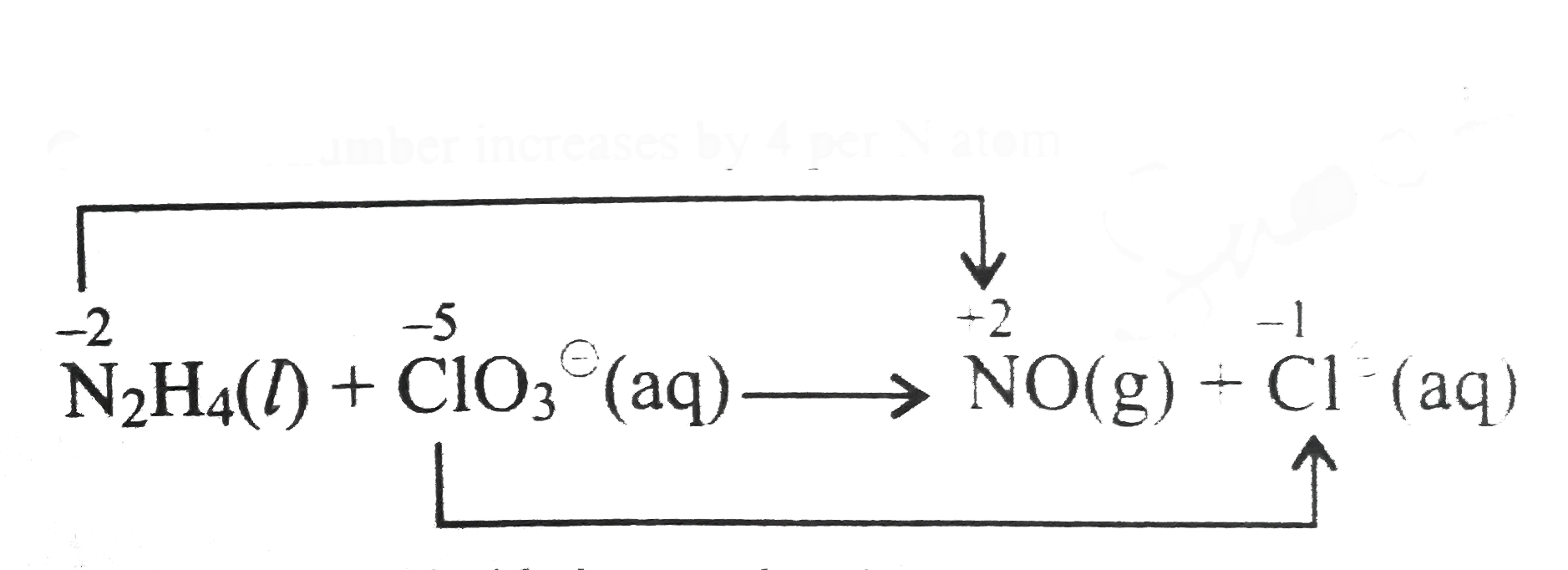Balance the following equations in basic medium by ion electron method and oxidation number method and identify the oxidising agent and the reducing agent.
P4(s)+OH−(aq)→PH3(g)+H2PO−2(aq)
a. 
P4 acts both as an oxidising as well as a reducing agent.
Oxidising number method:
Total decrease in oxidation number of P4 in
PH3=3×4=12
Total increase in oxidation number of P4 in
H2POΘ2=1×4=4
Therefore, to balance increase/decreases in oxidation numer multiply PH3 by 1 and H2POΘ2 by 3, we have,
P4(s)+ΘOH(aq)→PH3(g)+3H2POΘ2(aq)
To balance H atoms, add 3H2O to L.H.S and 3ΘOH to the R.H.S we have,
P4(s)+6ΘOH+3H2O(l)→PH3(g)+3H2POΘ2(aq)+3ΘOH(aq)
or
P4(s)+3ΘOH(aq)+3H2O(l)→PH3(g)+3H2POΘ2(aq)....(i)
Thus, Eq (i) represents the correct balanced equation.
Ion electron method:
Oxidation half equation
P4(s)→H2POΘ2(aq)....(ii)
Balancing P atoms, we have,
0P4(s)→4H2+1POΘ2(aq)
Balancing oxidation number by adding electrons,
P4(s)→4H2POΘ2(aq)+4e−
balance charged by adding ΘOH ions
P4(s)+8ΘOH(aq)→4H2POΘ2(aq)+4e−....(iii)
O and H get automatically balanced. Thus, equation (iii) represents the balanced oxidation half reaction.
Reduction half equation
0P4(s)→−3PH3(g).....(i)
Balancing P atoms, we have,
P4(s)→4PH3(g)
Balance oxidation number by adding electrons,
P4(s)+12e−→4PH3(g)+12ΘOH(aq)....(v)
To cancel out electrons, multiply equation (iii) by 3 and add it to equation (v) we have,

or P4(g)+3ΘOH(g)+3H2O(l)→PH3(aq)+3H2POΘ2(aq)....(vi)
Thus, equation (vi) represents the correct balanced equation.

Therefore, N2H4 acts as the reducing agent while ClOΘ3 acts as the oxidising agent.
Oxidation number method:
Total increase in oxidation number of N=2×4=8
Total decrease in oxidation number of Cl=1×6=6
Therefore, to balance the increase/decrease in oxidation number multiply N2H4 by 3 and ClOΘ3 by 4 we have,
3N2H4(l)+4ClOΘ3(aq)→6NO(g)+ClΘ(aq)
To balance N and Cl atoms, multiply NO by 6 and ClΘ by 4 we have,
3N2H4(l)+4ClOΘ3(aq)→6NO(g)+4ClΘ(aq)
Balance O atoms by adding 6H2O,
3N2H4(l)+4ClOΘ3(aq)→6NO(g)+4ClΘ(aq)+6H2O(l)....(i)
H atoms get automatically balanced and thus equation
(i) represents the correct balanced equation.
Ion electron methd.
Oxidation half equation
−2N2(l)→+2NO(g)
Balance N atoms,
N2H4(l)→2NO(g)+8e−
Balance charge by adding ΘOH ions.
N2H4(l)+8ΘOH(aq)→2NO(l)+8e−
Balance O atoms by adding 6H2O,
N2H4(l)+8ΘOH(aq)→2NO(g)+6H2O(l)+8e−....(ii)
Thus, equation (ii) represents the correct balanced oxidation half equation.
Reduction half equation
+5ClOΘ3(aq)→−1ClΘ(aq)
Balance oxidation number by adding electrons,
ClOΘ3(aq)+5e−→ClΘ(aq)
Balance charge by adding ΘOH ions,
CiOΘ3(aq)+6e−→ClΘ(aq)+6ΘOH(aq)
Balance O atoms by adding 3H2O,
ClOΘ3(aq)+3H2O(l)+6−→ClΘ(aq)+6ΘOH(aq)...(iii)
Thus, equation (iii) reprsents the correct balanced reduction half equation.
To cancel out electrons gained and lost, multiply equation out electrons gained and lost, multiply equation (ii) by 3 and equation (iii) by 4 and add, we have,
3N2H4(l)+4ClOΘ3(aq)→6NO(g)+4ClΘ(aq)+6H2O(l)
This represents the correct balanced equation
c. 
Thus, Cl2O7(g) acts an oxidising agent while H2O2(aq) as the reducing agent.
Oxidation number method:
Total decrease in oxidation number of Cl2O7=4×2=8
Total increase on oxidation number of H2O2=2×1=2
Therefore to balance the increase//decrease in oxidation number multiply H2O2 and O2by4, we have,
Cl2O7(g)+4H2O2(aq)→ClOΘ2(aq)+4O2(g)
To balance Cl atoms multiply ClOΘ2 by 2, we have,
Cl2O7(g)+4H2O2(aq)→2ClOΘ2(aq)+4O2(g)
To balance O atoms, add 3H2O to RHS, we have
Cl2O7(g)+4H2O2aq→2ClOΘ2(aq)+402(g)+3H2O(l)
To balance H atoms, add 2H2O to R.H.S and 2ΘOH to L.H.S, we have

This represents the balanced redox equation.
Ion electron method:
Oxidation half equation
H2−1O2(aq)→0O2(g)
Balance oxidation number by adding electrons,
H2O2(aq)→O2(g)+2e−
Balance charge by adding ΘOH ions.
H2O2(aq)+2ΘOH(aq)→O2(g)+2H2O(l)+2H2O(l)+2e−
Balance O atoms by adding H2O
H2O2(aq)+2ΘOH(aq)→O2(g)+2H2O(l)+2e−....(i)
Reduction half equation:
+7Cl2O7(g)→+3ClOΘ2(aq)
Balance Cl atoms
Cl2O7(g)→2ClOΘ2(aq)
Balance oxidation number by adding electrons,
Cl2O7(g)+8e−→2ClOΘ2(aq)....(ii)
Add ΘOH ions to balance charge
Cl2O7(g)+8e−→2ClOΘ2(aq)+6ΘOH
Balance O atom by adding 3H2O to L.H.S, we have, Cl2O7(g)+3H2O(l)+8e−→2ClOΘ2(aq)+6ΘOH(aq)..(ii)
To cancel out electrons, multiply equation (i) by 4 and add it to equation (ii), we have , 4H2O2(aq)+8ΘOH(aq)+Cl2O7(g)Cl2O7(g)+3H2O(l)→2ClOΘ2+(aq)+6ΘOH(aq)+4O2(g)+8H2O(l)

Topper's Solved these Questions
- NCERT BASED EXERCISEBOOK - CENGAGE CHEMISTRY ENGLISHCHAPTER - NCERT BASED EXERCISEEXERCISE - Atomic Structure
94 Videos
- NCERT BASED EXERCISEBOOK - CENGAGE CHEMISTRY ENGLISHCHAPTER - NCERT BASED EXERCISEEXERCISE - Thermodynamics
50 Videos
- NCERT BASED EXERCISEBOOK - CENGAGE CHEMISTRY ENGLISHCHAPTER - NCERT BASED EXERCISEEXERCISE - Chemical Equilibrium
73 Videos
- ISOMERISMBOOK - CENGAGE CHEMISTRY ENGLISHCHAPTER - ISOMERISMEXERCISE - Assertion-Reasoning Type
1 Videos
- ORGANIC REACTION MECHANISMBOOK - CENGAGE CHEMISTRY ENGLISHCHAPTER - ORGANIC REACTION MECHANISMEXERCISE - Analytical and Descriptive
6 Videos
Similar Questions
Balance the following equations in basic medium by ion electron method and oxidation number method and identify the oxidising agent and the reducing agent.
N2H4(l)+ClO−3(aq)→NO(g)+Cl−(g)
View SolutionBalance the following equations by ion electron method.
Sn+NO−3+H+→SnO+NO+H2O
View SolutionBalance the following equations by ion electron method:
a. CuO+NH3→Cu+H2O+N2
View SolutionBalance the following equations by ion electron method.
Cl2+OH−→Cl−+ClO−+H2O
View SolutionIdentify the oxidising and reducing agents in the following reactions.
S+4HNO3→SO2+4NO2+2H2O
View SolutionBalance the following equations by oxidation number method.
HNO3→H2S→NO+S+H2O
View SolutionBalance the following equations by oxidation number method.
MnO2+HCl→MnCl2+Cl2+H2O
View SolutionBalance the following equation by oxidation number method.
Cu+HNO3→Cu(NO3)2+NO+H2O
View SolutionBalance the following equations by oxidation number method.
NaOH+Cl2→NaCl+NaClO3+H2O
View SolutionIdentify the species undergoing oxidation & reduction and oxidising agent & reducing agent in the reaction.
I2(g)+H2S(g)→2HI(g)+S(s)
View Solution
